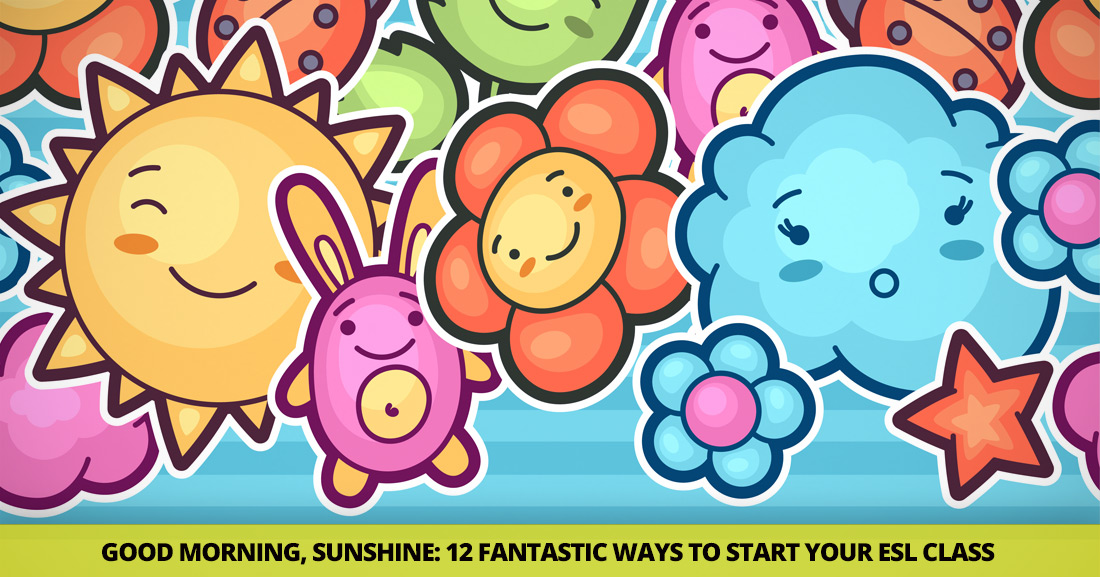Good Morning, Sunshine: 12 Fantastic Ways to Start Your ESL Class


Here are some ideas you can use with your adult (and kid) classes to get things started today.

Have your students arrange themselves in a circle, and then give them a simple question to answer. Student’s then take turns throwing the ball to a person in the circle and then answering the question. If you like, have students throw the ball to a classmate and then choose their own question to ask.
Simon says is a fun activity that requires students to listen closely. Try starting your day with a round of “Teacher Says”. Students will have to listen closely and follow your commands. If you like, use the game as a chance to review vocabulary or other topics you have covered in class.
This is a simple game that gets students talking to each other. As each student enters the room, put a sticky note on their back with the name of a person. You might choose anyone from celebrities to the members of your class. Students will then mingle and ask each other questions to determine who they are (the person on their back).
A simple paper bag can be a great way to start the day. You can put one object in the bag and ask a student to volunteer to feel it without looking at it and then describe it to the class. Another option is to put several items in the bag. Give each person ten to fifteen seconds to feel inside and then list as many objects as they recognized and remembered. See who remembered the most items.
Make your vocabulary review interactive by having students pull a word from a hat. Then see if they remember what the word means by acting out a charade, drawing a picture for the class to guess, giving its definition, or using it correctly in a sentence. Give everyone in class a chance to come to the front of the room and pull a vocabulary word if time permits.

Before students arrive in class, write a discussion question on the board. Then as students enter they join in the conversation about the topic. You can either have the discussion as a class or put students into smaller groups as they arrive.
Sometimes the best thing you can do to start class is to simply chit-chat with your students. If you make small talk with them as they enter your classroom, you will not only get to know more about them, you will also be modeling for them how to make conversation with just about anyone.
The beginning of class is a great time to check homework with your students. Though it may seem overly simple, it will actually benefit your students in many ways. It will serve as a review of previous material as well as activating the schemata for what you will be teaching today.
I love to give my students a chance to share interesting language experiences they have had outside of class. Sometimes students share new vocabulary they have learned, talk about successes with native speakers, or share other ways they used language successfully. Giving your students some time for this at the start of class will not only let them toot their own horns, it will also give courage to the rest of the class that they, too, can be successful in challenging language situations.
Rather than putting a question on the board for students to discuss as they enter, try putting up an interesting photo instead. Students can talk about the setting, the people, and any other interesting elements in the picture.

It’s not very dramatic, but having students correct sentences you write on the board can be very helpful with their language learning. Put one or two sentences on the board that need corrections, give students a chance to do it on their own, and then give them the correct answer. It gives you an easy context to review grammar and can be good for drawing attention to errors students consistently make without pointing fingers.
Wake up your students’ minds with a brainstorm race. Have them work individually or in groups of up to three to brainstorm as many of a particular item as they can. You can have them list articles of clothing, colors, or anything you can think of. This is a good way to integrate a topic you will be studying that day (i.e. brainstorm at the start of class rather than in the middle of a lesson) and saving on class time later.
As simple as it sounds, repeating an activity you did another day is a great way to get students ready to learn new things. You do not have to take time giving instructions, you can reuse materials you prepared at another time, and it’s a good way to review quickly.
This activity involves repeating an activity in class, but unlike the last opener, students can choose their own activity to repeat. Have a center set up with worksheets, activities, and other materials you have used in class. When students enter, they choose an activity to do at their desks to start the day.
Quizzes might be stressful for some students, but they are a good way to get class started. And just because you call it a quiz doesn’t mean it has to count toward your students’ grades. Give your students a short quiz on whatever topic you have studied lately, and it will give you a good read on how well the class grasped it. Plus, if you give quizzes to start the day often enough, your students will become experts at taking them and will do even better when it’s time to give the ones that count.
There are lots of activities you can do to get class started. With a little trial and error, you will find what works best for you and your students. It may be something physical that gets them up and moving or it may be quiet, independent work that gets their thoughts back on English. Each class has a different personality, and different activities work better for each. The good news is, trying different warmers to start class is a fun way to experiment and get to know your students better.
What did we miss? What are your favorite warmers? What has works best for your students?